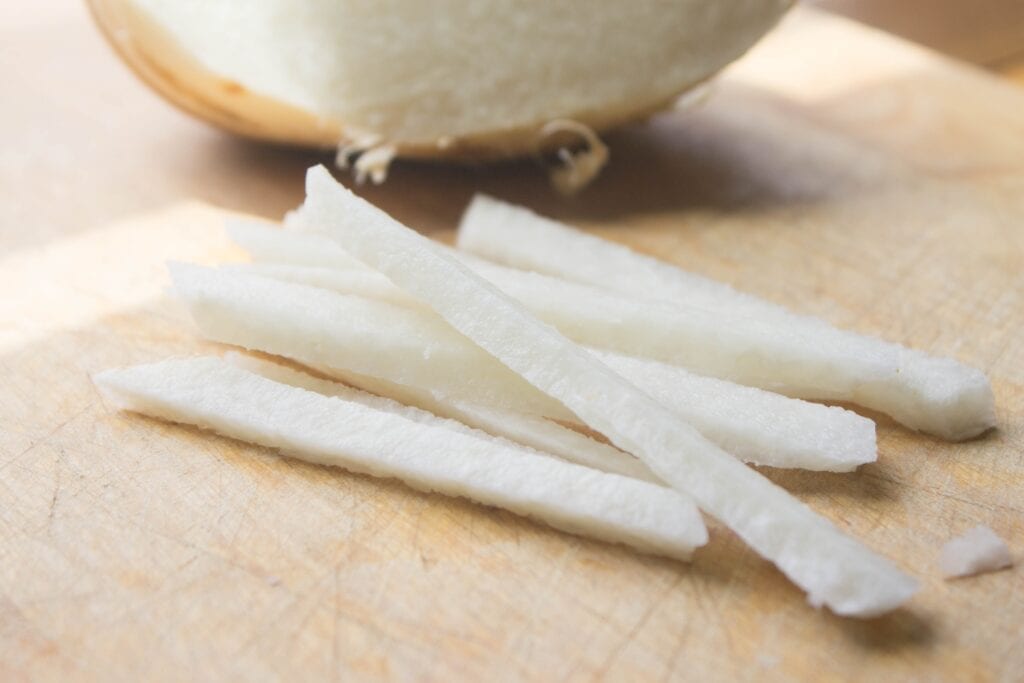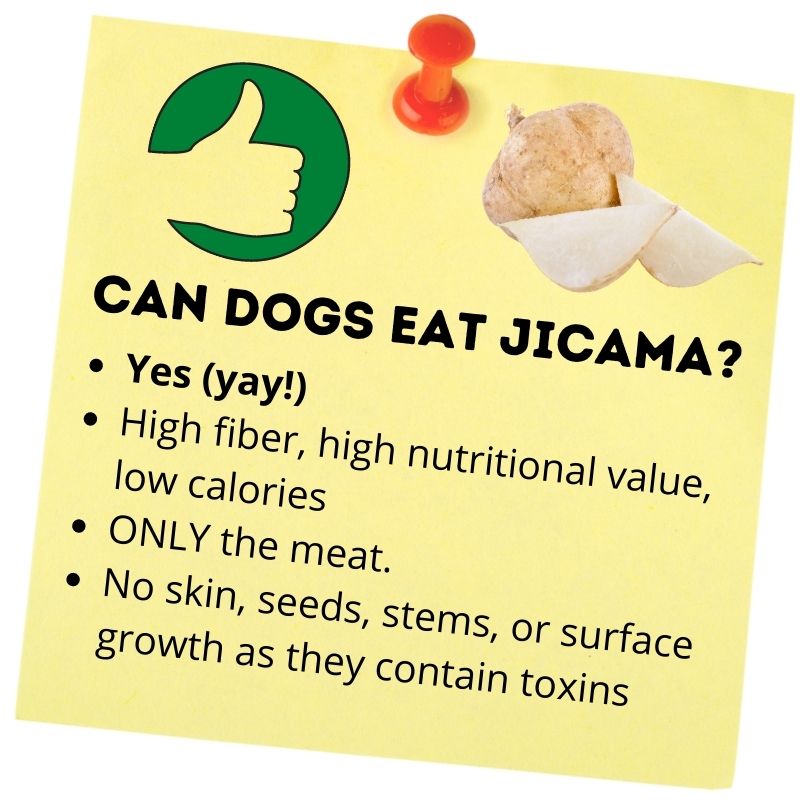
As dog lovers, we should always be careful about what our dogs eat. Many tend to feed them people food, and that’s sometimes fine, but other times it is not. Exercise caution as some foods, such as chocolate or garlic, can be dangerous and even fatal to dogs, while others, like olives, are usually fine. So what about Jicama? Can dogs eat jicama safely? Are there areas of concern to be aware of?
The short answer is, “yes, dogs can eat Jicama,” but, as always, there’s more to it. Understanding the details and what parts of the Jicama plant dogs can eat is important.
For more information about what your dog should and should not eat, be sure to take a look at our “Can dogs eat…” article, where we cover over 80 different items.
What is jicama?
Jicama is a starchy root vegetable with white fleshy meat and, although low in sugar, has a sweet flavor and satisfying crunch. For humans, it’s considered quite a powerful food in terms of nutrition, antioxidants, and high fiber content.
I’ve always likened jicama to a water chestnut. To me, the texture and flavor are similar. Others have said it’s like a cross between a pear and a potato. Some compare it to an apple, but not as sweet.
Whatever you compare it to, it’s tasty and good for you!
It goes by many other names. You’ll hear it referenced as the Mexican Yam Bean, Mexican potato, Mexican turnip, etc. Aside from “Chinese potato” and “Leafcup”, the many names do a good job of reflecting jicama’s Mexican origins.
Is jicama good for dogs?
Yes, jicama is good for dogs.
Jicama is densely packed with nutrients yet is low in overall calories. It’s a great add-on for your dog’s normal feeding routine.
Many down owners are trying to watch their dog’s weight, and you can do far worse than supplement their food with a few slices of jicama. The nutritional impact is high, and it is also high in fiber, so your pup will benefit.
As always, consult your veterinarian before trying new foods.
Feeding jicama to your dog

It’s important to understand that you’ll be feeding your dog the meat of the plant only. Not the skin, seeds, or any of the above-ground growth. Only the meat is safe as the seeds, stem, and skin contain small amounts of toxins and may contain pesticides. A little bit probably isn’t going to harm your dog, but why take the chance here?
Only feed your dog the jicama meat. Cooked or raw – either is fine. Raw will be a bit chewy, which dogs don’t seem to mind very much. Cooking will make even it out a bit in terms of chewiness and taste.
Humans tend to cook it, but it is tasty raw with a bit of lime juice or chili powder. I wouldn’t recommend the chili powder for your dog, though.
You’ll want to start small to ensure your dog handles it OK. A dog’s reaction to new foods can be messy if you know what I mean, so take it slow. Jicama is high in fiber also so that it can move along pretty quickly. If your dog tolerates it well, you can increase the amount. I caution against too much as dog food is still best. But as a small addition to the regular meal, there’s nothing wrong with it.
Health benefits of jicama for dogs and humans
For humans, the vitamin C content, many nutrients, and fiber mean that jicama is a great food for humans to eat. Same as for the dogs – nothing in that list is bad for dogs.
Actually, just the opposite.
On the decidedly human-focused website WebMD, the following are listed as health benefits for one medium-sized jicama:
- 32 grams of fiber – boost heart health and keeps you regular
- 12 grams of sugar
- 4 grams of protein
- 15-19% of the recommended daily allowance of Vitamin C
- Healthier than potatoes with far fewer carbohydrates
- High in vitamin B-6 for the brain, nerves, red blood cells, and energy
- Antioxidants to reduce the risk of cancer, diabetes, heart disease, and cognitive decline
- Prebiotics (inulin fiber) help restore good bacteria in the guts, which is necessary for good digestion, getting rid of bad bacteria, and helping to promote bowel movements.
- Hydration since jicama is 85% water
- Carbs with a low glycemic load so safe for blood sugar
- Jicama is also a powerful source of minerals such as phosphorous and calcium, which help ensure strong bones and good cartilage.
Look at that from a human point of view, and I have to wonder why I’m not eating far more jicama than I am. From a dog’s point of view, everything on there is equally nutritious.
There is no downside here.
So give Fido a treat of some jicama with the next meal. Fido will love it, and you can also feel good about it.
Are there risks if my dog eats jicama?
Not really, if you are careful.
- As with any fruit or veggie, you’ll want to wash it well to ensure no surface pesticides.
- As mentioned earlier, you’ll only be feeding your dog the meat of the bulb. The stems, seeds, and skin all contain a toxin called rotenone and can cause your dog to become very sick.
- Allergies – you never know. This is one of the reasons we recommend introducing new foods slowly and one at a time. If you introduce five new foods simultaneously, you won’t know which to blame if there is a problem.
- The ASPCA warns that feeding your dog any plant material may cause vomiting and gastrointestinal upset for dogs and cats.

Can dogs eat other vegetables?
Certainly!
As with jicama, this should be done sparingly and should not constitute the bulk of any of your dog’s meals, but veggies such as bell peppers, olives, edamame, or tomatoes are great snacks for your pup. Again, in moderation.
We have created a comprehensive list of foods your dog should and should eat: Can dogs eat…? 75+ food items reviewed
Can dogs eat jicama – recap
Can dogs eat jicama? Not only “can” they, but they also should! If they tolerate it well and you don’t overdo it. And you are careful only to give the meat of the plant, and jicama can be a healthy treat for your dog.
We often hear, “Can dogs eat [fill in the blank]” so we are working on a series of articles to discuss these topics. Please see our additional articles on our main dog health page.
Also, for a more informative overview about what your dog should and should not eat, be sure to take a look at our “Can dogs eat…” article, where we cover over 80 different items.
